Cherry Barb(Puntius titteya) is a small freshwater fish belonging to the Barb family. This is a popular aquarium fish introduced to many countries. The Barb gets its name from its bright red coloration. Its color is as red as a cherry hence called the Cherry Barb. This is a peaceful fish that does well in community aquariums and a hardy fish suitable for beginners and experienced aquarists. The fish is easy to care for and can be kept in various aquarium sizes.
This Barb is one of the most colorful fish in the world, and that is why it is so popular in the aquarium trade. This guide will discuss everything about cherry barbs, including their appearance, habitat, social structure, tank mates, etc.
This will be a complete guide for getting started with having them as your new aquarium pet. You will be able to acquire knowledge about their behavior, temperament, diet, distinct features, etc. So, with this note, let’s get started!
Table of Contents
- Species Summary
- Cherry Barb Care
- Food & Diet In The Wild
- Food & Diet In Captivity
- Feeding Frequency
- Feeding Methods
- All About Tank & Water Requirements
- Water Parameters
- Tank Size
- Lighting
- Filter
- Heater
- Cleaning & Maintenance
- Transportation & Handling
- Other Tank Accessories
- Substrate & Gravel
- Plants & Decorations
- Protein Skimmer
- Gravel Vacuum
- Test Kits
- Water Conditioner
- Cherry Barb Tank Mates
- Sexing The Cherry Barb
- How To Take Care Of Fry
- Different Color Of Cherry Barbs
- Common Possible Diseases In Cherry Barb
- Advantages Of Having Cherry Barbs In Your Tank
- Disadvantages Of Having Cherry Barbs In your tank
- Wrapping It Up
Species Summary
| Scientific name: | Puntius titteya |
| Common name: | Cherry barb |
| Origin: | Sri Lanka |
| Average size: | 2 inches (5cm) |
| Average lifespan: | 4-7 years |
| Color- | Bright red |
| Family- | Cyprinidae |
| pH range: | 6-8 |
| Water Hardness: | 5-19 dH |
| Temperature range: | 73°F-81°F |
| Diet: | Omnivore |
| Care level: | Easy |
| Temperament: | Peaceful |
| Tankmates: | Suitable with other small fish |
| Care level: | Easy |
| Swimming level: | Bottom |
| Social structure: | schooling |
| Minimum tank size: | 20 gallons |
| Breeding season: | Spring |
| Egg count: | 200- 300 |
| Troubleshooting: | The fish is prone to ich and velvet diseases. |
| Cost | Approximately $4 |
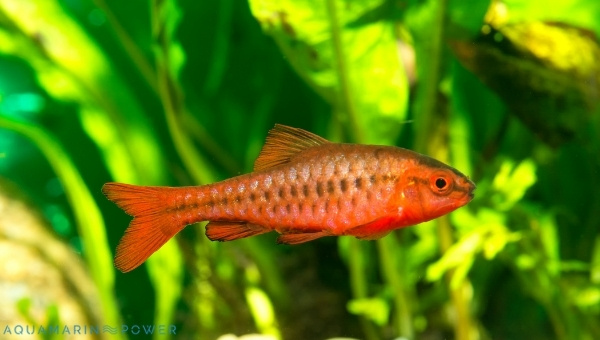
Appearance
The Cherry Barb is a small, bright red-colored fish with a torpedo-shaped body. The fish has two pairs of barbels to sense its surroundings. It also has a dark stripe that runs along its spine. The fish has a red body with black bars. The males are more brightly colored than the females. It has a slender body and a slightly upturned mouth. The dorsal and anal fins are also red.
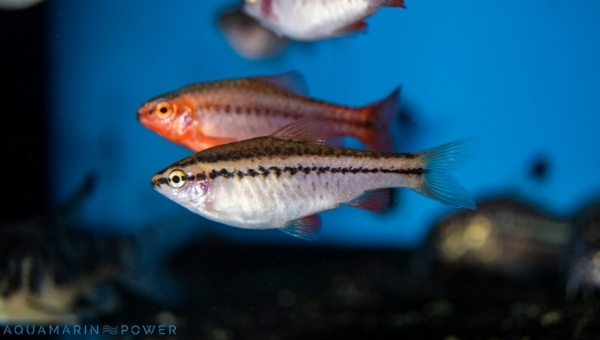
Some variants of the Cherry Barb may have a yellow body color. The eys are black, and there is a light-colored stripe running from the gills to the base of the tail. Overall the fish has very distinctive features, making it a strikingly beautiful creature to add to your tank. The red color of the fish adds too much beauty to the tank.
The Cherry Barb is named after the cherry fruit because of its red color. The fish was first discovered in Sri Lanka and was originally known as the red Barb.
Size & Lifespan
The Cherry Barb is a small fish that only grows to an average size of 2 inches. The lifespan of the cherry barb is 4-5 years, but with proper care, they can live up to 6-7 years.
Habitat
The Cherry Barb is a freshwater fish that prefers to live in warm waters. It likes to remain in freshwater but can also tolerate a slight amount of salt in the water. The fish inhabits various habitats, including ponds, ditches, marshes, and lakes. This is a schooling fish that prefers to live in groups.
Behavior & Temperament
The Cherry Barb is a peaceful fish that can be kept with various tank mates. They are relatively tolerant of different water conditions. The cherry barb is an active swimmer and will do best in a tank with plenty of open swimming space.
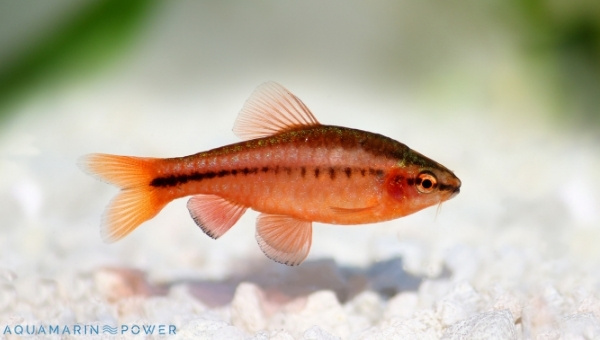
They are often seen swimming in schools of 10 or more fish in the wild. They make an excellent addition to any tank and are sure to bring hours of enjoyment to their keepers.
They are not aggressive and will not bother other fish in the tank. They are schooling fish and will do best when kept in groups of six or more. They are generally peaceful but may occasionally spar with each other. They can, at a time, become nippy with tank mates that are small and slow-moving.
Cherry Barb Breeding & Reproduction
If you are interested in breeding, it is important to provide them with a spacious tank. The tank should be at least 20 gallons in size.
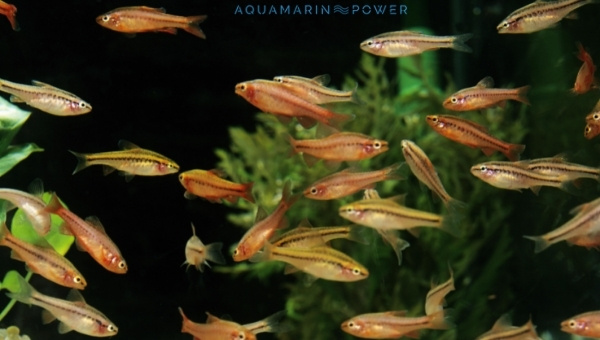
You will also need to provide them with plenty of plants and hiding places. We will now read about the breeding requirements, the process for reproduction, eggs, fry, how to take care of fry, etc.
Breeding Requirements
The water in the breeding tank should be slightly acidic and have a temperature of about 73°-81°F. You will also need to add a spawning mop or some Java moss to the tank. The female cherry barb will lay her eggs on the plants or the spawning mop.
After the female has laid her eggs, the male fertilizes them. It is important to remove the parents from the tank after they have spawned. The eggs will hatch in about 24-48 hours, and the fry will start to feed on their own a few days later.
Eggs & Incubation
Cherry barb eggs are very small and are clear in color. The female can lay anywhere from 100 to 300 eggs per spawn. The eggs will hatch in about 24-48 hours, and the fry will start to feed on their own a few days later.
Cherry Barb Care
The Cherry Barb is a hardy fish that is easy to care for. They are suitable for beginner aquarium keepers. The fish does not require special care and can adapt to various environments. They are strong and can tolerate a wide range of water conditions.
Food & Diet In The Wild
The Cherry Barb is an omnivore, and in the wild, it feeds on various food items, including insects, larvae, crustaceans, and plant matter. They like to feed on algae, aquatic plants, and small fish.
Food & Diet In Captivity
In captivity, the Barb can be fed a variety of food items. They will accept both live and frozen food items. The diet should include various food items such as brine shrimp, bloodworms, daphnia, tubifex worms, and flakes. They should also be given vegetables such as lettuce, spinach, and zucchini. The diet should be varied to ensure that the fish gets all the nutrients to stay healthy.
Feeding Frequency
The Cherry barb should be fed a small amount of food 2-3 times a day. Overfeeding can lead to health problems for the fish. Only give the fish as much food as it can eat in a few minutes. Giving too much food at once can also lead to water pollution. The excessive food will decompose in the water and pollute the water.
Feeding Methods
The Cherry Barb can be fed using a variety of methods. The most common method is to use a feeding spoon or dropper. You can also provide feed by hand. Another way is to place the food at the tank’s base and allow the fish to swim up to eat it. Let us discuss each method in detail.
- Feeding Spoon or Dropper: The feeding spoon or dropper is the most common method of feeding a fish. It is a simple and convenient way to feed the fish. The spoon or dropper allows you to control the amount of food you are providing the fish. You can also feed the fish using a syringe without the needle.
- Feeding by Hand: Feeding the fish by hand is another convenient way to feed them. This method is beneficial when you are feeding the baby or small fish. You can easily scoop up the fish and place it in your hand. You can then drop the food into its mouth. When feeding a large group of fish, this is the best method to use.
- Food at the Base of the Tank: Another way to feed the fish is to place the food at the tank’s base. This method is effective when you have a large group of fish. The fish will swim up to eat the food from the bottom of the tank. You can also use this method to feed live fish food such as brine shrimp.
All About Tank & Water Requirements
Tank and water requirements are the most crucial part of taking care of a fish. We shall see one by one each aspect.
Water Parameters
- Water Temperature Range: 73°-81°Fahrenheit
- Water pH Range: 6.0-8.0
- Salinity: <0.5%
- Ammonia: 0
- Nitrite: 0
Tank Size
The tank size should be at least 20 gallons. The height of the tank is not as important as the width and length. The dimensions of the must at least be 12 inches by 12 inches. The tank should be well-covered to prevent the fish from jumping out.
Lighting
The lighting requirements are not very high. The tank can be lit using a simple fluorescent light. The light should not be too bright as it can stress the fish. The bulb used must be a full-spectrum bulb to provide the fish with the necessary lighting.
Filter
The best filter for a cherry barb tank is a canister filter. A canister filter is a type of filter that sits outside of the tank. It is attached to the tank with hoses. The filter contains a number of different chambers that can be filled with different types of filtration media. This allows the filter to custom tailor the filtering process to meet the tank’s needs.
The best filtration media for a cherry barb tank are activated carbon and biological media. Activated carbon removes impurities from the water. Biological media provides a place for beneficial bacteria to grow. These bacteria help to break down the waste in the water. The filter should have a flow rate of at least 50 gallons per hour.
Heater
The heating requirements for the tank are not very high. A simple adjustable heater can be used to heat the water. The heater should be set to maintain a 73°-81°Fahrenheit water temperature. A heater is not necessary if the tank is located in a warm room.
Cleaning & Maintenance
Regular cleaning and maintenance of the tank are essential for the health of the fish. We shall see one by one each aspect of cleaning and maintenance.
- Cleaning the Tank: It is important to clean the tank regularly to remove debris and waste from the water. The frequency of cleaning will depend on the size of the tank and the number of fish. A small tank with a few fish will need to be cleaned once a week. A large tank with many fish will need to be cleaned more often. The first step in cleaning the tank is to remove the fish from the tank. The next step is to remove all of the decorations and plants from the tank. The last step is to clean the tank with a mild detergent. It is essential to rinse the tank well to remove all soap residues.
- Cleaning the Filter: The filter should be cleaned regularly to remove debris and impurities from the water. The first step in cleaning the filter is to remove it from the tank. The next step is to disassemble the filter and clean all parts with a mild detergent. It is important to rinse the filter well to remove all of the soap residues.
- Cleaning the gravel: The gravel should be cleaned regularly to remove debris and waste from the bottom of the tank. The first step in cleaning the gravel is to remove it from the tank. The next step is to rinse the gravel well under running water. The last step is to return the clean gravel to the tank.
- Water Changes: It is important to perform water changes regularly to remove impurities from the water. The first step in performing a water change is to remove the fish from the tank. The next step is to remove all of the decorations and plants from the tank. The last step is to remove about 25% of the water from the tank and replace it with fresh, clean water.
Transportation & Handling
The cherry barb is a delicate fish that should be handled with care. The fish should only be transported in a secure plastic bag. The bag should be filled with water from the tank. The fish should then be placed in an aerated cooler with ice packs. The cooler should be placed in a cool, dark place. The transportation time should be kept to a minimum to reduce stress on the fish.
After the fish has arrived at its destination, it should be acclimated to the new environment. The acclimation process should be done slowly over about an hour. The fish should be placed in a quarantine tank during this time. After the complete acclimation, the fish can be released into the main tank.
Other Tank Accessories
We will now look at what we can add to our tank. We will have a closer look at what kind of substrate and gravel we need, an ideal filter for the cherry barb, the best kind of plants and decorations, etc.
Substrate & Gravel
It is important to use the correct substrate and gravel in your tank. The substrate is the material that covers the bottom of the tank. The gravel is the material that is used to cover the substrate. Substrate and gravel provide a place for the fish to lay their eggs and hide from predators. The substrate also helps to anchor the plants in the tank.
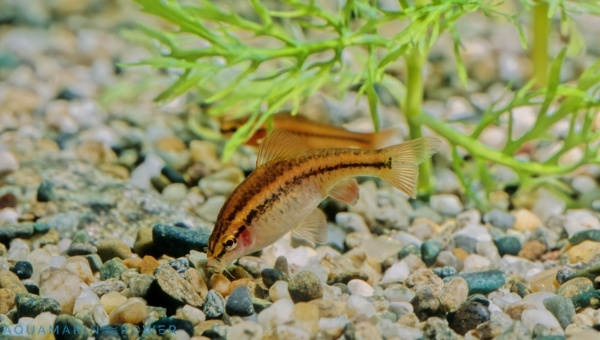
The best substrate for a tank is fine gravel or sand. The gravel or sand should be about 1/4 inch in size. You can also use crushed coral or limestone as a substrate. These materials will help keep the water’s pH in the correct range.
Plants & Decorations
The best plants for a Cherry Barb tank can withstand a wide range of water conditions. The plants should tolerate low light levels and a wide range of pH levels. The best plants for this purpose are anubias, java fern, and moss.
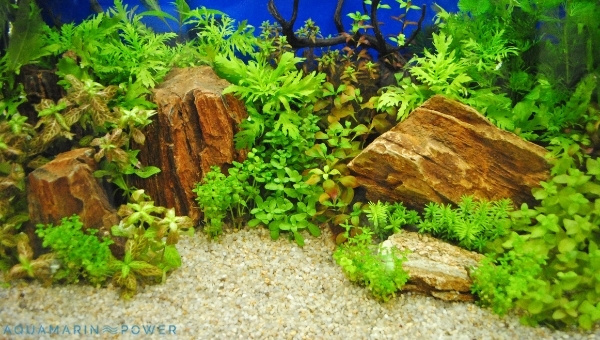
You can also use a variety of decorations in your tank. The decorations should be made from safe materials that will not leach toxins into the water. The best decorations for a cherry barb tank are driftwood, rocks, and caves.
Protein Skimmer
Another important aspect of setting up a tank is the protein skimmer. A protein skimmer is a device that removes impurities from the water. The skimmer works by passing the water through a chamber that contains a material that attracts and traps the contaminants. The impurities are then removed from the water by the skimmer.
Gravel Vacuum
A gravel vacuum is a device used to remove debris and waste from the gravel in the tank. The vacuum consists of a tube that is placed in the tank. The other end of the tube is connected to a pump. The pump pulls water through the tube and into the tank. The water then passes through the gravel and picks up debris and waste. The debris and waste are then removed from the tank by the vacuum.
Test Kits
It is essential to test the water in your tank regularly. You can use various test kits to test for different parameters. The most important parameters to test for are pH, ammonia, nitrites, and nitrates.
You can use various test kits to test for these parameters. The best test kits are those that use liquid reagents. These types of test kits are more accurate than strip tests.
Water Conditioner
It is important to use a water conditioner in your tank. The water conditioner will remove impurities from the water. It will also add beneficial chemicals to the water. The most important chemical that the water conditioner will add is chlorine. Chlorine is a chemical that kills bacteria.
The best water conditioners for a Cherry Barb tank contain aloe vera. Aloe vera is a plant that has healing properties. It will help to heal any wounds that the fish may incur.
Cherry Barb Tank Mates
The Cherry Barb is a peaceful fish that can be kept with various tank mates. The fish are compatible with most community aquarium fish. They can also be kept with other peaceful barbs.
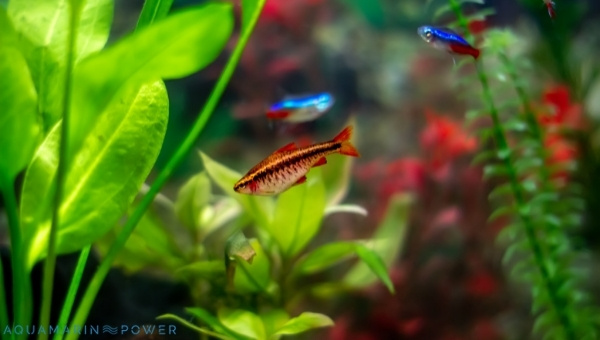
Some good tank mates for cherry barbs include:
- Tetras: The neon tetra is a popular choice for tank mates. They are peaceful fish that are compatible with most community aquarium fish.
- Gouramis: The pearl gourami is a good choice for tank mates. They are peaceful fish that prefer to live in groups.
- Danios: The zebra danio is also a great fit for tank mates. They are active fish that prefer to live in schools.
- Platies: The Mickey Mouse platy is good for tank mates. They are peaceful fish that are compatible with most community aquarium fish.
When choosing a tank mate for your cherry barb, it is important to select a fish compatible with your tank’s water conditions. You also want to choose a fish that is compatible with the size of your tank. Choosing a fish compatible with the Cherry Barb’s temperament is also important.
Other tankmates maybe
- Guppies
- Swordtails
- Barbs
- Cichlids
- Loaches
Sexing The Cherry Barb
It is not always easy to determine the sex of a Cherry Barb. One way to determine the sex of a Cherry Barb is by looking at the shape of its anal fin. The male has an anal fin that is pointed. The female has an anal fin that is blunt.
The males have a long and pointy dorsal fin, whereas the females have a shorter and rounder dorsal fin. Both sexes have a black bar on their caudal peduncle (tail fin), but the bar on the male is usually more intense.
Another way to determine the sex is by looking at their color. The male cherry barb is usually brighter in color than the female. The easiest way to determine the sex of a cherry barb is its color. The male has a red color, while the female has a more yellow-golden body.
How To Take Care Of Fry
Keeping the fry in a separate aquarium from the adults is important until they are large enough to be moved. The fry needs plenty of food and clean water to grow properly. You will also need to change the water in the fry tank often to prevent the water from getting too dirty. You can feed them baby brine shrimp, crushed flake food, or newly hatched brine shrimp.
Different Color Of Cherry Barbs
The cherry barb is a small fish found in a variety of colors. The most common color morphs are red, orange, and yellow. However, there are also less common color morphs, such as green, blue, and black. These rare color morphs are more expensive and are harder to find.
Common Possible Diseases In Cherry Barb
The Cherry Barb is a hardy fish, but they are susceptible to diseases and disorders. Some of the diseases and their symptoms, precautions, and medications are mentioned below.
- Ichthyophthirius multifiliis (Ich): This is a protozoan parasite that can cause white spots on the fish’s body. The fish may swim erratically and scratch themselves against objects in the tank. Precautions include maintaining a clean tank, adding aquarium salt to the water, and using Malachite Green or formalin medications.
- Leptospirosis: This is a bacterial disease that can cause lethargy, loss of appetite, and skin lesions. Precautions include maintaining a clean tank and using medications such as chloramphenicol or sulfa drugs.
- Velvet disease: This is a parasitic disease that can cause gold or brownish spots on the fish’s body. This is a protozoan parasite that can cause a velvet-like growth on the fish’s body. The fish may scratch themselves against objects in the tank and swim erratically. Precautions include maintaining a clean tank, adding aquarium salt to the water, and using Malachite Green or formalin medications.
- Columnaris: This is a bacterial disease that can cause lethargy, loss of appetite, and ulcers in the fish’s body. Precautions include maintaining a clean tank and using medications such as chloramphenicol or sulfa drugs.
Cherry Barbs are also susceptible to stress-related disorders such as fin rot and scale drop. Stress can be caused by poor water quality, inadequate diet, or overcrowding. Before giving any medication, it is essential to consult a veterinarian or a fish specialist. This will ensure the safety of your fish and avoid any mistakes.
Advantages Of Having Cherry Barbs In Your Tank
There are several advantages of having them in your tank. Some of these advantages are:
- The cherry barb is a small fish that does not require a lot of space.
- They are also peaceful fish and will not bother other fish in the tank.
- This makes them a good choice for community tanks.
- They are also easy to care for and do not require special attention.
Disadvantages Of Having Cherry Barbs In your tank
While there are several advantages of having them in your tank, there are also some disadvantages. Some of these disadvantages are:
- The cherry barb is a small fish that larger fish may bully.
- They are also peaceful fish and may not do well in tanks with aggressive fish.
- This can make them the wrong choice for tanks with large fish.
- The cherry barb also requires a lot of space and may not be suitable for small tanks.
Wrapping It Up
In conclusion, the Cherry Barb is a beautiful and interesting fish that makes a great addition to any aquarium. It is a schooling fish that prefers to live in groups. A well-maintained tank will also prevent the spread of diseases. Ensure that you can provide them with the environment they need to thrive.
The Cherry Barb is a beautiful addition to any freshwater aquarium. They will surely add bright color and excitement to your tank. Cherry Barb will be perfect if you are looking for a non-aggressive and easy-to-handle fish.
We hope that this guide helped you with the basic yet essential information you need to have about the Cherry Barb before adding them to your tank. So, that’s all there is to know about the Cherry Barb. Just follow all the above-mentioned simple steps, and you’ll be on your way to having a beautiful tank filled with happy fish!



